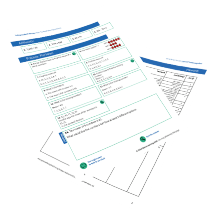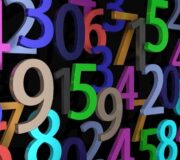What Is Mean In Maths And How Can You Calculate An Average? Explained For Primary School
Find out what the definition of mean and average are, when they are taught in school, and how you can help children to understand mean and average as part of their maths learning at home.
What is mean?
Mean is a type of average used to calculate an average of a given data set.
To find the mean average value or arithmetic mean of your data, you must first add up all the numbers. Then you need to divide this sum of the values by the number of data points (or total number of numbers).
There are also other types of mean, such as ‘sample mean’, ‘geometric mean’, and ‘harmonic mean’ that use the sum of the numbers of a dataset to calculate the average value.
However, using the mean is not the only way to find the average of a data set. There are other types of averages or measures of central tendency, including:
- The median – which is also known as the middle number or middle value
- The mode – or modal number is the data value which occurs the most
- The range – which is the difference between the smallest value and highest value
Mean maths examples
Visualising mean
Mean is often taught and explained through abstract methods as soon as students in Year 6 are capable of manipulating the required numbers needed to find the mean or average amount. However, it is important that students understand what is happening when they are finding the mean of a data set.
The pictures below show just that.
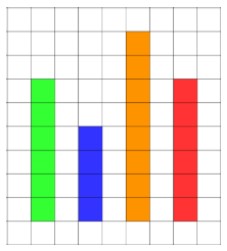
If this represented a data set of points scored by four teams in a game, we could find the mean by adding up all the data points and dividing the sum by the number of data points in total. While this reaches the answer of a single number, it does not provide a conceptual understanding of what is happening to that data.
Before getting students to carry out an algorithm, it would be better to demonstrate to them what is happening when they carry out this process.
By finding the mean, we want to find the average points scored in a game across all teams. The way to do this would be to see if we can get all data points to the same height by manipulating the data (when doing this with a class, I would get them to make these representations physically with cubes or counters).
FREE Independent Recap Mean Worksheet
This time-saving worksheet is for Year 6 pupils and includes 4 arithmetic questions, 9 consolidation questions, and 1 challenge question.
Download Free Now!Read more: Concrete Pictorial Abstract
We can see that by removing two orange cubes and placing them on top of the blue cubes, then all data points would have the same value.
This is demonstrated in the next picture.
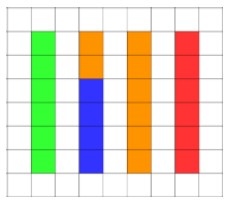
With all data the same height, we can see that the mean average is the size of each part when a quantity is shared equally.
How do you calculate mean?
To find the mean, you first need a set of values. This can be obtained by any means, but it is more meaningful when it can be related to your class. Here’s a frequency table containing discrete data (rather than grouped data) with no outliers.
| Name | Number of books read |
| Fred | 5 |
| Harry | 4 |
| George | 1 |
| Dudley | 2 |
| Ron | 5 |
| Arthur | 3 |
| Ginny | 8 |
| Albus | 4 |
As mentioned earlier, to find the mean average value, you must first add up all the given set of data points and divide the sum by the total number of values. This means that students will need to first find the total number of books read by the class.
As they are in Year 6, I would encourage them to use their mental arithmetic skills to find the total by looking to make number bonds that they are comfortable with. Going in ascending order, 5, 4 and 1 make a number bond to 10.
2, 5 and 3 make a number bond to 10.
8 and 4 make 12, so this gives a total of 32.
The next step would be to divide 32 by the number of values that are in the (bimodal) data set. As there are 8 students, 32 would have to be divided by 8. Students should be able to use their multiplication facts (8 × 4 = 32) to know that 32 divided by 8 would give 4. This would make the mean value of the set of numbers above 4.
When do children learn about mean and average in school?
Whilst studying statistics, students in Year 6 will be expected to learn how ‘to calculate and interpret the mean as an average’. Year 6 students have always had to work out the mean as an average, but before the amended national curriculum in 2014 came into effect, students also had to work out the median mode and range. The 2014 curriculum amendments only made it mandatory to teach mean.
Read more: Teaching Statistics And Data Handling KS2
How do mean and average relate to other areas of maths?
Finding the mean can improve the fluency of addition skills when having to add up a number of data sets, and can encourage students to use mental maths methods to do these additions. Students can also find more complex averages from fractions and decimals as well as data sets with both positive numbers and negative numbers. Likewise, it can help students practice seeing division as the inverse of multiplication.
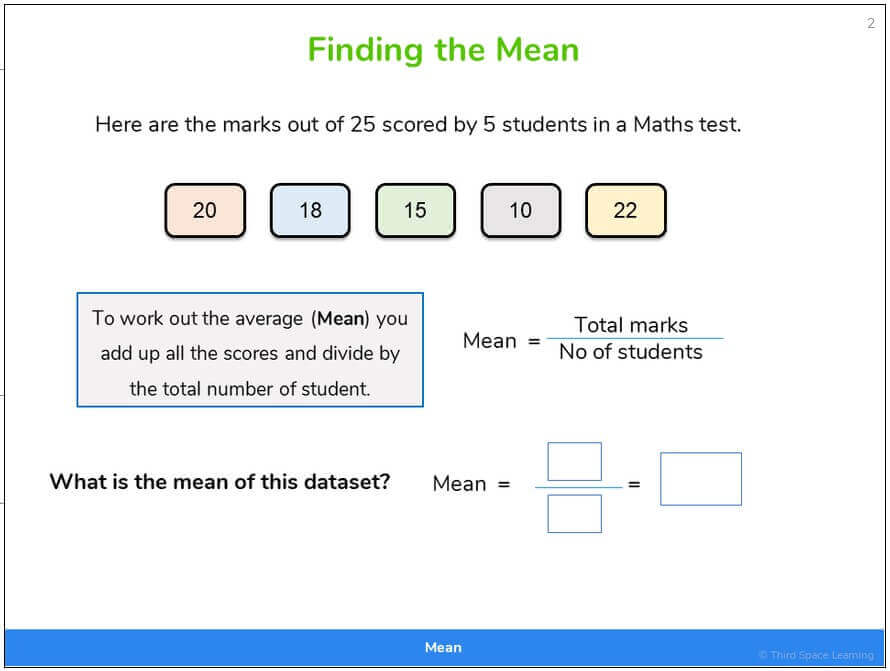
Read more: What Is Fluency In Maths & How Do Schools Develop It?
How do mean and average link to real life?
Finding the mean is just one of the ways that people find averages out of a set of data. The Office for National Statistics uses mean to find the average age of the population. Any role that involves looking at data will likely use the mean to help draw conclusions from the data.
Mean maths worked examples
Let’s go through some step-by-step worked examples for calculating the mean in maths.
1. Find the mean.
| Name | Number of detentions in a year |
| Fred | 18 |
| Harry | 35 |
| George | 21 |
| Ron | 26 |
To find the mean, first, add all the data sets.
To solve this, we need to add the list of numbers, 18, 35, 21 and 26. This is 100.
Next, we divide by the number of data sets. As this data is for 4 people, the number of data sets is 4. This means we need to divide 100 by 4. This is 25.
2. Find the mean.
| Name | Number of merits |
| Fred | 45 |
| Harry | 37 |
| George | 43 |
| Ron | 46 |
| Ginny | 54 |
To find the mean, first, add all the data sets.
To solve this, we need to add 45, 37, 43, 46 and 54. This is 225.
Next, we divide by the number of data sets. As this data is for 5 people, the number of data sets is 5. This means we need to divide 225 by 5. We can do this by partitioning 225 into 200 and 25. 25 divided by 5 is 5 and 200 divided by 5 is 40. When these are added together, you get 45.
The mean number of merits is 45.
Mean maths practice questions
1. Use a concrete manipulative to share these quantities out equally.
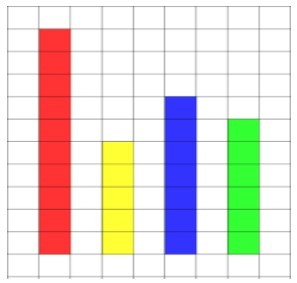
Answer: Each row should have 7 blocks.
2. Complete this sentence stem:
To find the mean, first ______ all the data sets and then ______ by the ______ of data sets.
Answer: To find the mean, first add all the data sets and then divide by the number of data sets.
3. Find the mean.
| Name | Number of books read |
| Fred | 7 |
| Harry | 4 |
| George | 2 |
| Dudley | 4 |
| Ron | 3 |
Answer: The mean is 4.
4. Joshua has tried to find the mean. Can you spot his mistake?
| Pig 1 | Pig 2 | Pig 3 |
| 54kg | 55kg | 59kg |
54 + 55 + 59 = 168kg
168 ÷ 6 = 28
The mean weight is 28kg.
Answer: Joshua’s mistake is that he divided by 6 and not 3.
5. Find the mean.
| Name | Number of cookies eaten |
| Trevor | 25 |
| Pritesh | 32 |
| Janice | 28 |
| Moe | 35 |
| Sue | 30 |
Answer: 126
A mean in maths is the average of a data set, found by adding all numbers together and then dividing the sum of the numbers by the number of numbers. For example, with the data set: 8, 9, 5, 6, 7, the mean is 7, as 8 + 9 + 5 + 6 + 7 = 35, 35/5 = 7.
The mean is the average of two or more numbers.
The mean is 3.
Wondering how to explain other key maths vocabulary to your children? Check out our Primary Maths Dictionary and take a look at What Are Mean Median Mode Range?
DO YOU HAVE STUDENTS WHO NEED MORE SUPPORT IN MATHS?
Every week Third Space Learning’s specialist school tutors support thousands of students across hundreds of schools with weekly online 1 to 1 maths lessons designed to plug gaps and boost progress.
Since 2013 these personalised one to one lessons have helped over 150,000 primary and secondary students become more confident, able mathematicians.
Learn how the tutoring integrates with your SEF and Ofsted planning or request a personalised quote for your school to speak to us about your school’s needs and how we can help.

